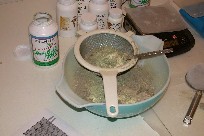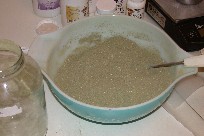Supplements - In Practice
This section contains information about the practical usage of supplements.
Powders - Measurement
In order to economize and/or avoid capsule and filler ingredients, many individuals use supplement powders. To facilitate dosage measurements, suppliers of supplement powders generally provide density information by printing on the container's label, the weight of an amount of powder measured by an included scoop or a standard household measuring spoon. Sometimes the specification is for a rounded or heaping (scoop, 1/4 teaspoon, etc), but most often nothing additional is stated which implies the measuring instrument should be leveled as closely as possible. However, new batches of the powder from either the same or different manufacturing sources (suppliers most often are not the original manufacturers) frequently have different densities than previous ones; ie. the weight of powder in a given volume can be more or less than for previous lots. Unfortunately, the suppliers of the powders that we use (Life Extension Foundation and Beyond a Century) print the weight per volume for a product on the label which they do not change with each lot (even though LEF does stamp the lot number on each label). Nor do either of them provide lot basis information on their websites or include it as a product insert. The result of this (and possibly of incorrect initial product labeling and measurement methods - either on the part of the supplier or the end user) is that many powder users are likely taking dosages far different from what they desire. It is for purpose of attempting to rectify this situation that we have done the work to provide the information here.
Even measuring as accurately as possible, we have found that volume measurements of powders are fraught with inexactness. Household measuring spoons can vary considerably from one manufacturer to another. We have two sets of measuring spoons and have determined that the more expensive stainless steel set is 98% of the actual stated volume based on the weight of water (5 ml = 1 tsp = 5 gram); the cheaper aluminum set is 104%. In addition, leveling methods used by different individuals may alter the weight contained within the volume tool used by as much as 10%. Therefore, for those people who are seriously interested in accuracy concerning their dosage of supplement powders and are taking substances that need to be measured in small or precise quantities, we recommend the purchase of a 0.01 gram (10 mg) accuracy digital scale so that this problem (of weight measurement by using volume measurement) cannot occur.
Dillon Precision is the source of the small scale we keep in Toronto (though our particular Ohaus model is no longer available) and the one we keep in AZ. LEF now offers a Determinator Digital scale by way of an apparent arrangement with Dillon Precision.
We initially measured the densities for supplement powders that we take in both our "Morning Potion" and our "Meal Cocktail". We have also detailed the events which led us to expend this effort, the correspondence with the suppliers of our powders, and their response to our information. We more recently added similar information for the rest of our regimen powders.
TOP
Powders - Dry Mixing
We are providing a detailed list of steps which Kitty follows using a fresh printout of Excel spreadsheet files she keeps updated for the "Meal Cocktail" and previously for the "Breakfast Potion" prior to the changes of 4/30/04 which consolidated almost all the ingredients. (Click on photos to enlarge.) Weights of powders are for 40 days worth of dosages (20 days for 2 people assumed to be the same weight). Two scales are used to provide both weight accuracy and capacity. The larger scale has capacity for 400g with 100mg accuracy (400g x 0.1g, as given in the literature), while the smaller is a 75g x 0.01g scale. (In AZ we keep a 55g x 0.01g scale and purchased in Dec 2003 an Ohaus Scout II similar to the one we have in Toronto.)
 Set-up for mixing the old Breakfast Potion (The only difference in equipment with the combo Meal Cocktail is that mixing is currently being done in our 6 qt stainless steel soup pot since the pyrex mixing bowl is not large enough for the total amount of powder.)
Set-up for mixing the old Breakfast Potion (The only difference in equipment with the combo Meal Cocktail is that mixing is currently being done in our 6 qt stainless steel soup pot since the pyrex mixing bowl is not large enough for the total amount of powder.)
- Start with the Lutein or Herbal Mix (the largest quantity for the Meal Cocktail and the old Breakfast Potion, respectively, and both green - both are used in the new combo Meal Cocktail) and use approximately 1/8 of it in the sieve (coarser of the 2 when using the Herbal mix due to larger particles) placed over the large pyrex mixing bowl.
-
Using the 0.01 gram scale for the small quantity powders (the 0.1 gram for the larger), weigh out the appropriate amounts for other powders placing them in small groups into the fine sieve. Sift the lighter powders into the Lutein or Herbal Mix.
- Sift the combined powders into the bowl. Add more Lutein or Herbal Mix as needed, interspersing with weighed amounts of the smaller quantity powders.
 Start of Mixing old Breakfast Potion
Start of Mixing old Breakfast Potion
 Adding smaller weighed powders into Herbal Mix
Adding smaller weighed powders into Herbal Mix
- Grind BHT in mortar with pestle adding with other fine powders to Lutein.
- When all powders have been measured and sifted into the pyrex bowl, spoon amounts of it back through the coarse sieve. It is not uncommon for a few "large" hard lumps to collect in the sieve; these Kitty grinds with the mortar and pestle and returns to the mix.
 Final mixing of old Breakfast Potion through sieve
Final mixing of old Breakfast Potion through sieve
- During measuring steps, note any shortage of powders for final calculation of individual dose from total weight of powders.
- Use a large mixing spoon and stir powders until no congregates of a single powder are seen; around and up & over methods. (This is Paul's job - "therapeutic mixing".)
Note: Rutin tends to remain in little clumps. So after Paul has stirred for final uniformity, he then rotates the bowl working with the powder as a radial "cliff" which crumbles as he removes its base. As it crumbles it reveals the small clumps which are easily squashed against the side of the bowl, and integrated with the other powder. Doing this causes them not to reclump. When he sees no clumps bigger than millimeter size he is done with this process.
 old Breakfast Potion ready for jar storage
old Breakfast Potion ready for jar storage
- Spoon (w/ same large utensil) the powder mix into wide mouth 2L clear glass jar for the old separate powder mixes (originally held dill pickles). (We would use a dark glass jar if we had one the proper size. But at the start, the clear jar was useful to see that the mix remained uniform. The new combo Meal Cocktail is too much in quantity for one of the large glass jars and two don't fit well in our refrigerator. Instead we are using a LEF whey container.)
- Calculate the volume of a single dose in this manner:
- Total (on spreadsheet) the weight of the powders; small shortages are not uncommon;
- Divide the total by # days(40) and divide by #doses/day (3) for the weight of a single dose;
- Adjust Paul's and Kitty's doses for the meal cocktail. We do this by computing our lean weights and taking proportionate amounts of the powdered mixes. The proportionate amounts have been 1.2 x for Paul and 0.8 for Kitty for over 2 years, and the resulting daily amounts ingested are noted on our individual regimen pages (Paul and Kitty).
- Determine the volume of these single doses by using a variety of measuring spoons and the scale.
- Label the jar with the date of mix and volume of single dose (# & type of measuring spoons - we have 2 sets) for each of us (so we don't forget since it's not always the same due to changes and shortages).
This whole process, including setup and cleanup, took about two man hours for each powder set (meal and pre-breakfast when they were separate) but about three hours total for the combo mix. However, spread over 40 person-days, this averages to only 4.5 minutes per person-day, actually down from the 6 mins prior to the combining. (But to be absolutely fair, there is another minute spent each day in putting the 2 remaining powder items from the original Breakfast Potion into tomato juice and taking it only at that time.)
When we the separate powder mixes were in clear glass jars we couldn't help but examine the bulk dry powder mixes daily. No aggregates of other powders could be seen in the mainly (by volume) green lutein powder. Turmeric in the Meal Cocktail could be seen to have a tendency to leave a very fine film on the inside of the glass jar, but it brushed off when the powders were agitated. The use of the single large plastic whey container has not changed the quality of the mix once transferred to it. If we can locate a 4L glass jar in the future, we will use it because of the visual and cleaning advantage glass provides. For now we will discard the whey container every couple, if not every, mixing since the containers are readily availble.
We hope this helps to make clear how our bulk powder mixing is done and that such mixing of our supplement powders can be practically achieved by this method. Sometime in the future when tasks permit, Kitty will take photos showing the arrangement being used since the 4/30/04 change to combine almost all powders in to the Meal Cocktail.
MoreLife is Always "Under Construction"
Page last updated 11/3/04.
Any questions, comments or suggestions regarding the content of this website
should be addressed at MoreLife Yahoo.
For comments on webpage format, contact Kitty Antonik Wakfer
 Set-up for mixing the old Breakfast Potion (The only difference in equipment with the combo Meal Cocktail is that mixing is currently being done in our 6 qt stainless steel soup pot since the pyrex mixing bowl is not large enough for the total amount of powder.)
Set-up for mixing the old Breakfast Potion (The only difference in equipment with the combo Meal Cocktail is that mixing is currently being done in our 6 qt stainless steel soup pot since the pyrex mixing bowl is not large enough for the total amount of powder.)  Start of Mixing old Breakfast Potion
Start of Mixing old Breakfast Potion Adding smaller weighed powders into Herbal Mix
Adding smaller weighed powders into Herbal Mix Final mixing of old Breakfast Potion through sieve
Final mixing of old Breakfast Potion through sieve old Breakfast Potion ready for jar storage
old Breakfast Potion ready for jar storage